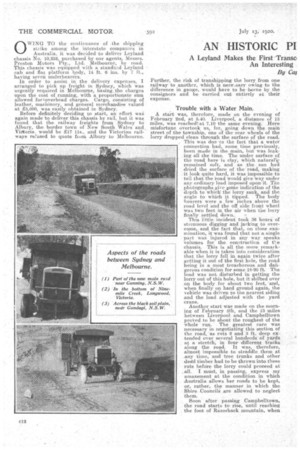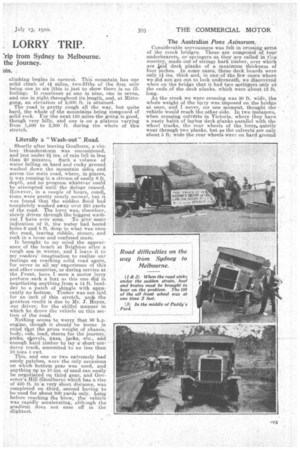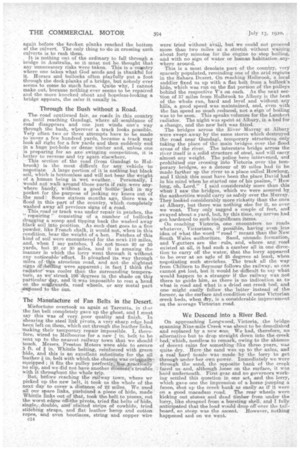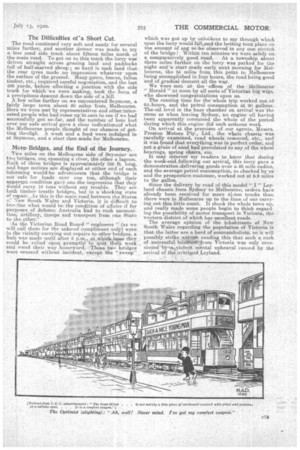AN HISTORIC PI
Page 10

Page 11

Page 12

Page 13

If you've noticed an error in this article please click here to report it so we can fix it.
• LORRY TRIP.
A Leyland Makes the First Transo An Interesting 'rip from Sydney to Melbourne. the Journey.
0 WINGTO the continuance of the shipping strike among the interstate companies in Australia, it was decided to deliver Leyland chassis No. 10,252, purchased by our agents, Messrs. Preston Motors Pty., Ltd. Melbourne, by road. This chassis was equipped with a standard Leyland Gab and flat platform bpdy, 14 ft. 6 ins. by 7 ft.,
having seven underbearers. .
in order to assist in the delivery expenses. I arranged to pick up freight in Sydney, which Was urgently required in Melbourne, basing,the charges upon the cost of.running, with a proportionate surd allowed fortioverhead charges. Cargo, consisting of leather, machinery, and general merchandise valued at £5,000, was easily obtained in Sydney.
Before definitely deciding to start, an effort -Wai again made to deliver this chassis by rail, but it. was found, that the railway freights from Sydney to Albury, the border town of New South Wales and, Victoria,. would be £17 11s., and the Victorian railways rOused to quote from Albury to Melbourne.
Further, the risk of transhipping the lorry. from one railway to another, which is nece,sary owing to the difference in gauge, would have to he•tkorne by the consignors and be carried out entirely at their expense.
Trouble with a Water Main.
A start was, therefore, made on the evening of February 2nd, at 5.40. •Liverpool, a distance of 13 miles, was reached rat 7.10 the same evening. Here misfortune overtook us, for going down the main street of the township, one of the rear wheels of the lorry dropped clean through the surface of the road. This was due to the fact that a water connection had, some time previously, been made in the main, but was leaking all the time. The under surface of the road here is clay, which naturanif remained soft, and as the sun had dried the surface of the 'road, making . it look quite hard, it was impossible to tell that the /road would_ive Way under any ordinary•load imposed upon it. The photographs give othe indication of the depth to which' the lorry sank, and the. angle to which it tipped. The body bearers were a few inches above the road level and the off side front wheel was two feet in the air when the lorry finally settled down.
This little incident took 36 hours of strenuous digging and jacking to overcome, and the fact that, on close examination, it was found that not a single part was injured in any way speaks volumes for the construction of the chassis. This is all the more remarkable when it is taken into consideration that the lorry fell in again twice after getting it out of the first hole, the road being in a most treacherous and dangerous condition for some ,18-20 ft. The load was not disturbed in getting the lorry out of this hole, but it shifted over on the body for about two feet, and, when finally on hard ground again, the vehicle was driven to the nearest siding and the load adjusted with the yard crane.
Another start was maiie on the morning of February 4th, and the 13 miles between Liverpool and Campbelltown proVed to be about the roughes-t of the whole run. The greatest care was necessary in negotiating this section Of the road, •as. rote 2 and 3 ft. deep extended over several hundreds of yards . at a stretch, in four different tracks along the road. It was, therefore, almost impos,sible to straddle them at any time and tree trunks and other deascl timber had to be thrown into these ruts before the lorry could proceed at. ,a11., -I must, in passing, express my amazement at the condition in which Australia allows her roads to be kept, or, rather, the manner in which the .Shire Couneiis are alloWed to neglect them.
Soon after passing •ca.mpbelltown, the road starts to rise, until reaching . the foot of Razorback mountain, when
climbing begins in earnest. This mountain has one solid climb of 4i1 miles, .two-fifths of the first mile being one in six (this is just to show there is no illfeeling). It continue's at one in nine, one in seven, and one in eight throughout its length, and, at Mittogong, an elevation of 2,000 ft. is attained.
The road is pretty rough all the way, but quite hard, the whole of the mountains being composed of aolid rock. For the next 150 miles the going is good, though very hilly, and one is on a plateau varying from 1,500 to 2,300 ft. during the whole of this stretch. •
Literally a "Wash-out ".Road.
Shortly after leaving Goulburn, a virilent thunderstorm was -encountered, and just under 24 ins, of rain fell in less than 20 minutes. Such a• volume of water falling on hard and rocky ground washed down the mountain sides and across the main road, where, in places, it was running in a stream of easily 6 ft. depth, and no progress whatever could be attempted until the deluge ceased. However, in a couple of hours, condi, tions were pretty nearly normal, but it was found that the sudden flood had "completely washed away over 250 yards of the road. The lorry was, therefore, slowly driven through the biggest washout I have ever seen. To give some indication of it, the water had bored holes 6 and 8 ft, deep in what was once the road, leaving rubble, stones, and rock in a loose and confused mais. _
It brought to my mind the appearance of the beach at Brighton after a rough sea in winter, and I leave it to my readers' imagination to realize our feelings on reaching solid road again, for never in all my' experience of this and other countries, or during service at the Front, have I seen a motor lorry perform such a feat as this one did in negotiating anything from a 14 ft. boulder to a patch of shingle with apparently no bottom. Timber was not laid_ for an inch of this stretch, an the greatest credit is due to Mr. J. Heyes, our driver, for the skilful manner in which he drove the vehicle on this section of the road.
Nothing seems to worry that 36 h.p, engine, though it should be borne in mind tb,at the gross weight of chassis, body, cab, load, stores for the journey, picks, shovels, axes, jacks, etc. and enough hard timber to lay .a short corduroy track, amounted to no less than 10 tons 4 cwt.
This, and one or two extremely bad sandy patches, were the only occasions On which bottom gear was used, and
anything up to 10 ins, of sand can easilybe negotiated on third gear, and Gov
ernor's Hill (Goulburn) which has a rise of 450 ft. in a very short distance, was completed on third, second having to be used for about 500 yards only. Lon before reaching the brow, the vehicle was rapidly accelerating, although the gradient does not ease off in the slightest.
The Australian Pons Asinorum.
Considerable nervousness was felt in crossing some of the creek bridges. These are composed of four
underbearers, or springers as they are called in thiscountry, made out of stringy bark timber, over which are 4aid deck planks of a maximum thickness of four inches. In some cases, these deck boards were only 1-4 ins, thick and, in one of the few cases where we did not get out to look underneath, we discovered when on the bridge that it had two springers only at the ends of the deck planks, which were about 12 ft.. long.
As the creek we were crossing was 30 ft. wide, the whole weight of the lorry was imposed on the bridge at once, and I never, ror one moment, thought the vehicle would reach the other side. In two instances, when crossing culverts in Victoria. where they have a -nasty habit of laying deck planks parallel with the wheel tracks, the rear wheels of the lorry, quietly Went through two planks, but as the culverts are only about 5 ft.. wide the rear wheels were on hard ground
again before the' broken planks reached the bottom of the culvert. The only thing to do in crossing such culverts is to rush them.
It is nothing out of the ordinary to fall through a bridge in Australia, so it must not be thought that any unnecessary risks were taken. This is a: coontry where one takes what God se•nds and is thankful for it. Horses and bullocks often playfully put a foot through the deck planks of a bridge, but nobody ever seems to come to much harm. Quite why, I cannot make out, because nothing ever aeons to be repaired and the more knocked about and hopeless-looking a bridge appears, the safer it usually is.
Through the Bush without a Road.
The road continued fair, as roads in this country go, until reaching Gundagi, where all semblance of road disappears and one just winds one's way through the bush, wherever a track looks possible. Very often two or three attempts have to be made to 'cover a few hundred yards, because a track may look all right for a few yards and then suddenly end in a huge pot-hole or dense timber and, unless one is preparing for an axe swinging competition, it is ,.better to reverse and try again elsewhere. This section of . the road (from Gundagi to Holbrook) is the most difficult for any vehicle to negotiate. A large portion of it is nothing but Mack soil, which is bottomless and will not bear the *eight of a human being in Wet weather. Personally, I would not walkaround those parts if rain were anyWhere handy; without a go d bottle jack in my Pocket for the purpose of jacking my knees out of the mud! Some sixteen months ago, there was lItted in this part of the country, which completely washed away all previous signs of a road.
_ This road or track was under repair in patches, the "repairing" consisting of a number of bullocks dragging a scoop and tipping back the washed away black Soil into position. As such -dust goes to a fine Powder; like French chalk, it would not, when in. this condition, bear the weight of a hen. Patches of this kind of soil were encountered for the next 110 miles, and, when I say patches. I do not Mean 20 or 30 yards, but 20, or 20 miles, and it is amazing the manner in which the. lorry went through it without any noticeable 'effort. It ploughed its way through miles ofthia atrocious road, and not the slightest signs af :!,laffiltng were apparent; in facej think the radiatorwas cooler than the surrounding temperature, as We:. struck 102, Angrees in the shade on ail particular day, and it was impossible to rest a haat on the maieguards, road wheels-, or any metal putt
osed to the Sun. •
The Manufacture of Fan Belts in the Desert.
Misfortune overtook us. again at Tarcutta, in that the fan belt completely gave up the ghost, and I must say this was of very poor quality and finish. In 'shearing the steel. Erik pivots, a very sharp edge had been left on them, which out through the leather rinks, 'making their temporary repair impossible. I, there' "fbre, wired to Melbourne for a new in. bolt to be sent up to the nearest railway town that-we should tench. Messrs. Preston Motors were able to secure 14 ft. of in. Whittle belting, reinforced with green -hide, and this is an excellent substitute for the all leather in belt with which the chassis, was origigalky
• equipped ; it fits the pulley perfeetlyaliaas Practically no slip, and wedid not have another ifrOitierit:s trotibie with it throughout the whole trip.
But, Wore reaching the railway town, where we picked up the new belt, it toek, us the whole of the next day to cover a distance of 22 miles. We need all our spare rinks, purloined a piece of hide, made Whittle links out of that, took the belt to pieces,' out the worst edges 'off;the pivots, tried flat belts of hide, single, e double, and` plaited strips of cowhide, tried stitching straps, and flat leather hemp and cotton ropes, and even b•ootia.ces, string and copper wire
c14
were tried without avail., but we could not proceed moue than to miles at a stretch without waiting about forty minutes. for the engine to stop boiling, and with no sign. of \valet: or human habitation anywhere around.
This is a most desolate part of the country, very sparsely populated, reminding one of the arid regions in the Sahara Desert. On reaching Holbrook, a local
saddler fixed us up with a fiat belt from a bullock's hide, which was run on the flat portion a the pulleys
behind the respective V's an each. As the next sec tion of 37 miles from Holbrook to Albury is the best of the whole run hard and lever and without any
hills, a good speed was raaintained, and, even with the fan speed so much reduced, not a sign of boiling was to be seen. This speaks volumes for the Lambert radiator. The night was spent at Albury, in a bed for a change, and the new belt was fitted.
The bridges across the River Murray at Albury were swept away by the same storm which destroyed the road near Gundagi, temporary structures only taking the place of the main bridges over the flood areas of the river. The interstate bridge across the river itself is a solid structure of steel, and will carry. • almost any weight. The police here intervened, and prohibited our creasing into Victoria over the tem porary bridges, se a detour of 20 miles had to be made farthea up the river to a place called Howlong, and I think this nutat have been the place David had in his mind When he started one of his psalms, "Hew long, oh, Lord." I said considerably more than this when I saw the bridges, which we were assured by the authorities would carry us safely over the Murray. They looked considerably more rickerty than the ones at Albury, but there was nothing else for it, so over. we went. They only sagged a couple of feet, a.nct swayed about a yard, but, by this time, my nerves had • got hardened to such insignificant items.
On reaching Victoria, one encounters no roads whatever' Victorians, if possible, having even less
idea of what the word road" means than the New South Wales. authorities. Sand,. unmade formation, and V-gutters are the rule, and, where any. roa,d existed at .all, it had such a camber all in one direc tion to carry off the water, that the lorry appeared to be over at art agle, of 25 degrees at least, when negotiating such stretches. The track all the way from Chiltern to Seymour follows the railway,so one cannot get last, but it would be 'difficult to say whit would happen to a stranger if the railway was not
there to guide him, as there is no indication. as to What is road and what is a dried out creek bed, and one might easily follow the latter instead of the former, as the surface and condition of some Victorian creek beds, when etry, is a considerable improvement on the average Victorian road.
We Descend into a River Bed.
On approaching Longwood, Victoria, the bridge spanning Nine-mile Creek was about, to be demolished and replaced by a new aim We had, therefore, no alternative but to drop straight down into the creek bed,'W-hich, needless to reinark, owing to the absence of decent rains for something like three years, was quite dry. Here the sand was up to the axles, and' a real hard tussle was • made by the lorry to get through under her own power. Immediately we were through . the sand, the opposite bank of the ereek fa.ced us and, although loose on the surface, it was hard underneath. First gear and no governors workmg settled thiS question in one act, and the lorry, which gave one the impression of a horse jumping a fence, shot up the creek bank as easily as if it were on a good macadam road. The rear wheels were kicking out stones and dead timber from under the
like' shrapnel from a bursting shell, and I fully anticipated that the load would drop off over the tailboard, so steep was the ascent. However, nothing happened and on we went.
The Difficulties of' a Short Cut.
The road continued very soft and sandy for several miles further, and another detour was made to try a less used side track about fifteen miles north of the main road. To get on to this track the lorry WaoS driven straight across -grazing land and paddocks full of half-.starved sheep ; so hard is such Land that the rear tyres made .noimpression whatever uponthe surface of the ground. 'Many gates, fences, fallen timber, etc., required careful negotiation, and the last 400 ;yards, before effecting a junction with the side track for which we were making, took the form. of a precipitous descent down the side of a hill.
A few miles further on we encountered Seymour, a fairly large town about 60 miles froin Melbourne. Here we were met by representatives and otherinterested people who had come upin ears to see if we had successfully got see far, and the number of bets lost over our safe arrival gave k clear indicaticrniof what the Melbourne people thought of our chances of get, ling thrafigh. A wash and a feed were indulged in at Seymour, and a start then made for Melbourne.
More Bridges, and the End -Of the Journey.
Two miles on the Melbanrne side of Seymour are two bridges, one spanning a river, the other a lagoon. Each of these bridges is approximately 350 ft. long, and huge notices are displayed at either end of each informing would-be adventurers that the bridge is not safe for loads cier one ton, although their apparent condition gave one the impression that they would carry 10 tans without any trouble. They are both timber trestle bridges, but in a 'shocking state of rep-air. .As this is the main road between the States rew South Wales and Victoria, it is difficult to irre..ine what would be the condition of affairs if for purposes of defence Australia had to rush ammunition artillery, troops and transport from one State to the other.
As the Victorian Road Board " engineers " (as we will call them for the saketof compliment only) were in the vicinity.carrying out repairs to ether bridges, a halt was. made until after 5 p.m., ataylaiel*.,boux they could be relied upon promptly" to quits their_ work and wend their way homeward.-These two bridges were -crossed without incident, except the "sweep"
which was got up by onlookers to say through which span the lorry would fall,andthe betting took place on tne amount of sag to -be-observed in any one stretch of the bridge! Within ten minutes we were safely on a comparatively good :read. At a township about three milat further on the lorry was parked for the night and'a startmade early next morning for Melbourne, the 55 miles from this point to Melbourne being accomplished in four hours, the road being good and of ,gradual descent all the way. We were met at the offices of the Melbourne " Herald " at noon by all sorts of Victorianbig wigs, who showered congratulations upon us. The running time for the whole trip worked outat 64 hours, and • the petrol consumption at 96 gallons. The soil fevel in the base chamber on arrival was the same as when leaving Sydney, no engine oil having been apparently consumed the whole of the period during which this engine did such arduous work.
On arrival at the premises of our agents, Messrs. Preston Motors Pty., Ltd., the whole chassis was carefully examined, road wheels removed, etc., and it Was found that everything was in perfect order, and not agrain of sand had percolated to any of the wheel bearings, spring Chairs, etc.
It may interest My readers. to know that during the week-end, following our arrival, this lorry gave a demonstration.delivering goods over a 25 mile, radius, and the-average petrol consumption, as checked by us and the prospective customer, worked out at 9.9 miles
to the ,gallon. • Since the delivery by road ofthis model " I " Leyland chassis from Sydney to Melbourne, orders have already been received for more 4i-ton trucks tha-n there were in Melbourne up to the timeof our. carrying out this little stunt. It shook the whole town up, and re-ally made some people begin to think regarding the passibility of motor transport in Victoria, the western district of which has excellent roads.
The average opinion 'of the inhabitants of New South Wales regarding the population of Victoria is that the latter are a herd of somnambulists, so it will possibly strike .1.*,./9:we reading this that such a rush
of 'suceessful• busitiOV•.friain Victoria was only occa• , sioned h a.:vioient mental upheaval caused by the arrival or the overland Leyland.




























